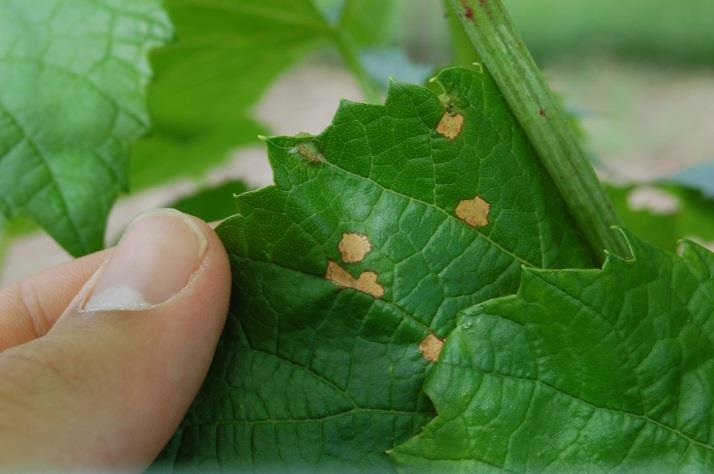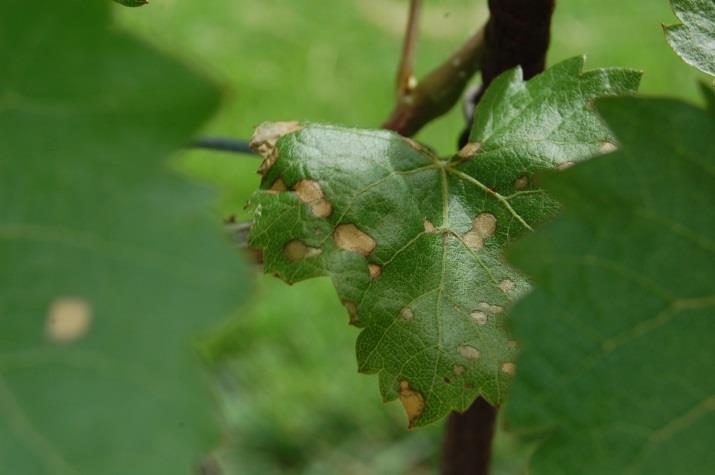Grape Disease Update June 10, 2016
Summer temperatures have arrived for most of Wisconsin, with daily temperatures climbing into the 70s and 80s over the past week in most grape-producing regions of the state. In addition to the warm temperatures, we have had numerous rain events over the past two weeks across the state. While this weather has sped up grape growth, these warm, wet conditions have also been ideal for disease development.
PARS. As of June 8th we had accumulated 340 GDD (base 50) and had recorded 10 rain events in the previous two weeks, with more in the forecast in the next several days. Development is slower than at WMARS in this region. Shoots are between six inches and one foot in length, and early bloom is several days away. No disease has been detected at this site thus far. Growers in this region should be monitoring wild grape blooms in addition to weekly scouting to keep tabs on when bloom will occur. Wild grapes bloom several days before our cold-climate wine hybrids, so tracking wild grape development is a useful tool for initiating a spray schedule. A protective spray against downy mildew and black rot will need to be made shortly before bloom.
WMARS. As of June 8th we had accumulated 503 GDD (base 50), and had recorded 9 rain events in the previous two weeks, again with more rain on the forecast for the next several days. Most cultivars are in bloom at this time, and shoots are between one to three feet long. Black rot symptoms were detected for the first time on ‘Marquette’ and ‘Valiant’ at WMARS on May 31st. Leaf lesions were widespread on the first 2-3 expanded leaves of shoots on both of these cultivars. This concentration on the oldest expanded leaves in the canopy is typical of early season black rot, so make sure that you are checking the oldest leaves on your shoots for lesions when scouting. Also make sure to look for the small, black “pimples” inside of the lesions. These are pycnidia (fungal fruiting bodies), and are used to diagnose black rot in the field.
Right: black rot lesions on a fully expanded young Valiant leaf. Notice the rings of tiny, black pycnidia (fungal fruiting bodies that are characteristic of black rot infection) as you scout. Photo by D.S. Jones
Growers across Southern Wisconsin should make sure they have a cover out for black rot over the next several weeks as grape blossoms open up. Research has indicated that grapes are at their peak susceptibility between early bloom and about 4- to 6-weeks post-bloom, and the weather we have been having throughout the region is highly conducive for black rot development. Black rot can infect in as little as 6 hours of leaf wetness at 80° F, so extreme care should be taken at this time of year to prevent crop loss.
Mancozeb provides excellent control for black rot, but remember that its use is restricted by a 66-day pre-harvest interval (PHI). Sterol-inhibitor fungicides also provide control against black rot, providing several days of post-infection activity. Several generic fungicides contain tebuconazole, a sterol-inhibitor chemistry. Strobilurin fungicides containing azoxystrobin are also effective, but should only be used as protectants, as the post-infection activity of these products is limited. It is also important to remember that several of these fungicides, such as Flint and Pristine, can cause severe injury to concord grapes. Many of the cold-climate wine grape varieties have concord grape (Vitis labrusca) or other American grape heritage, so great care should be used when selecting the appropriate product. Comments on phytotoxicity may be found in the 2016 Midwest Fruit Pest Management Guide.
Conditions across southern Wisconsin have also been ideal for downy mildew infections. Make sure that you are also inspecting the undersides of leaves throughout your vineyard as you scout. Remember that downy mildew will sporulate in white patches on the undersides of leaves. Additionally, we have found that some of our cold-climate cultivars can have sporulation on leaf undersides without the “oil spots” on the tops of leaves that are often also associated with this pathogen.
Ridomil Gold MZ and Ridomil Gold Copper provide excellent downy mildew control, but their uses are restricted by a 66-day PHI, and are meant for use only prior to bloom. Products containing phosphorous acid are also effective, but do not control other fungal diseases of grape and should only be used to control downy mildew rather than as a broad spectrum management practice. Strobilurin fungicides used as protectants (such as Sovran and Abound) provide good control with additional effectiveness against black rot and powdery mildew, but as previously mentioned it is critical to check for phytotoxic effects before applying strobilurin products because several other products (such as Flint and Pristine) can cause severe phytotoxic effects on cold-climate hybrid grapes. Copper-based fungicides are effective against downy mildew, and some formulations are approved for organic production. However, in our research on sensitivity of cold-climate cultivars to copper, ‘Brianna’ was highly sensitive, sometimes showing injury after just one application. Several other varieties showed injury, but only after four to six applications. See the Northern Grape News, February 18, 2016 for more on copper fungicide use (northerngrapesproject.org).
Having scouting troubles? Don’t forget about our diagnostic resources!
UW-Madison Plant Disease Diagnostic Clinic: http://labs.russell.wisc.edu/pddc/
UW-Madison Insect Diagnostic Lab: http://labs.russell.wisc.edu/insectlab/
UW-Madison Soil and Forage Lab: https://uwlab.soils.wisc.edu/fees/
This article was posted in Disease and tagged David S. Jones, disease, Grapes, Patty McManus.


